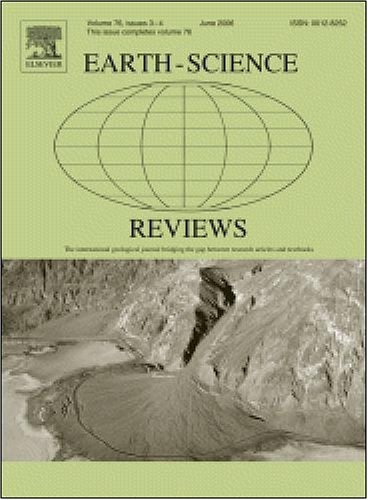Seismic hazard and shifting channels: Exploring coseismic river response
IF 10.8
1区 地球科学
Q1 GEOSCIENCES, MULTIDISCIPLINARY
引用次数: 0
Abstract
Large earthquakes can trigger cascading flood hazards that can influence societal risk and loss; however, the mechanisms driving coseismic river response (CRR) in seismogenic regions have not been fully characterized. This review synthesizes data from fifty-two global cases of CRR where surface deformation affected rivers and identifies the key physical and environmental parameters that control riverine flood hazard in earthquakes. We identify four primary CRR classes, ranging from channel-confined ponding to overbank flooding and avulsion, wherein a river shifts into an enduring new course within the floodplain. CRR susceptibility governs the likelihood, spatial extent, and longevity of CRR, and links back to the characteristics of the surface deformation, river planform, and host environmental setting. Dip-slip fault ruptures, with a large vertical separation at the surface capable of damming river channels, are the primary driver of CRR. Multi-meter dip-slip offsets are also linked to fault-block tilting, which reduce or reverse the gradients of overlying channels. These tilted fault blocks can induce coseismic flooding or avulsion away from the principal fault, with cases documented up c. 10 km upstream from the fault-river intersection. Lateral offsets can amplify or modulate CRR but are generally less effective than vertical offsets at causing them. Two-thirds of CRR cases occurred in single-thread rivers, the majority of which are meandering systems occupying intermontane or lowland basins. Liquefaction-prone substrates in these floodplains exacerbate CRR impacts through ground deformation that disrupts river channel profiles and the local water table. Overbank flooding, lake formation, and prolonged surface flooding are common outcomes near meandering channels and may occur away from the principal fault. Confined braided rivers with high width-to-depth ratios are more resistant to overbank flow and avulsion. In unconfined settings, erodible substrates, and low lateral bank stability amplify the potential for channel scour and rapid avulsion. Braided floodplains often host dense networks of paleochannels within their floodplain, and in any environment, paleochannels enhance the potential for, and geographic extent of flooding and avulsion. High discharge conditions elevate the potential for overbank flow and avulsion, and the hazard posed by CRR may be higher in regions where the climate is perennially or seasonally wet. The risk posed by CRR during earthquakes is heightened in areas where population expansion and land reclamation in flood and liquefaction-prone zones is commonplace. A method to assess CRR risk in advance is required, and a probabilistic framework incorporating uncertainties in fault behaviour, recurrence intervals, and flood-rating curves may offer a way to evaluate absolute hazard in areas where faults and rivers intersect. Site-specific hydrodynamic modelling can further quantify potential changes in flood patterns in high-hazard, high-exposure areas, paving the way for assessing societal and economic risks. We suggest the need is urgent in places such as India and Bangladesh's Ganges-Brahmaputra-Meghna delta. This densely populated region, home to ∼150 million people, is underlain by a locked plate boundary and active faults. Historic earthquakes in the region suggest that future large seismic events could trigger widespread changes in flood hazard, exacerbating the existing risk posed by flooding.
地震灾害和移动通道:探索同震河流反应
大地震可能引发层叠式洪水灾害,影响社会风险和损失;然而,在发震区,同震河流响应的驱动机制尚未得到充分表征。这篇综述综合了52个地表变形影响河流的全球CRR案例的数据,并确定了控制地震中河流洪水危害的关键物理和环境参数。我们确定了四种主要的CRR类型,从河道限制的池塘到河岸上的洪水和崩解,其中河流在洪泛区内转变为持久的新河道。CRR敏感性决定了CRR发生的可能性、空间范围和寿命,并与地表变形、河面和宿主环境背景的特征联系在一起。倾斜断层的破裂,在地表具有较大的垂直分离,能够阻塞河道,是CRR的主要驱动因素。多米的倾滑偏移也与断块倾斜有关,这降低或逆转了上覆河道的坡度。这些倾斜的断块可能导致同震洪水或远离主断层的崩解,在断层-河流交汇处上游约10公里处就有记录。横向偏移可以放大或调制CRR,但在引起CRR方面通常不如垂直偏移有效。三分之二的CRR病例发生在单线河流,其中大多数是占据山间或低地流域的曲流系统。这些洪泛平原上容易液化的基底通过地面变形加剧了CRR的影响,破坏了河道剖面和当地的地下水位。河岸上的洪水、湖泊的形成和长时间的地表洪水是曲流河道附近的常见结果,也可能发生在远离主断层的地方。具有高宽深比的狭窄辫状河更能抵抗过岸流和崩裂。在无限制的环境中,可侵蚀的基材和较低的侧岸稳定性增加了河道冲刷和快速撕裂的可能性。辫状洪泛区在其洪泛区内通常有密集的古河道网络,在任何环境下,古河道都增加了洪水和崩解的可能性和地理范围。高流量条件增加了河堤溢流和崩解的可能性,在气候多年性或季节性湿润的地区,CRR造成的危害可能更大。在洪水和液化易发地区,人口扩张和土地开垦司空见惯的地区,地震期间CRR带来的风险更高。需要一种预先评估CRR风险的方法,一个包含断层行为、复发间隔和洪水等级曲线不确定性的概率框架可能提供一种评估断层和河流相交地区绝对危险的方法。特定地点的水动力模型可以进一步量化高危险、高暴露地区洪水模式的潜在变化,为评估社会和经济风险铺平道路。我们认为,印度和孟加拉国的恒河-布拉马普特拉河-梅克纳河三角洲等地急需援助。这个人口稠密的地区拥有约1.5亿人口,位于锁定的板块边界和活动断层之下。该地区的历史地震表明,未来的大型地震事件可能引发洪水灾害的广泛变化,加剧洪水造成的现有风险。
本文章由计算机程序翻译,如有差异,请以英文原文为准。
求助全文
约1分钟内获得全文
求助全文
来源期刊

Earth-Science Reviews
地学-地球科学综合
CiteScore
21.70
自引率
5.80%
发文量
294
审稿时长
15.1 weeks
期刊介绍:
Covering a much wider field than the usual specialist journals, Earth Science Reviews publishes review articles dealing with all aspects of Earth Sciences, and is an important vehicle for allowing readers to see their particular interest related to the Earth Sciences as a whole.
 求助内容:
求助内容: 应助结果提醒方式:
应助结果提醒方式:


